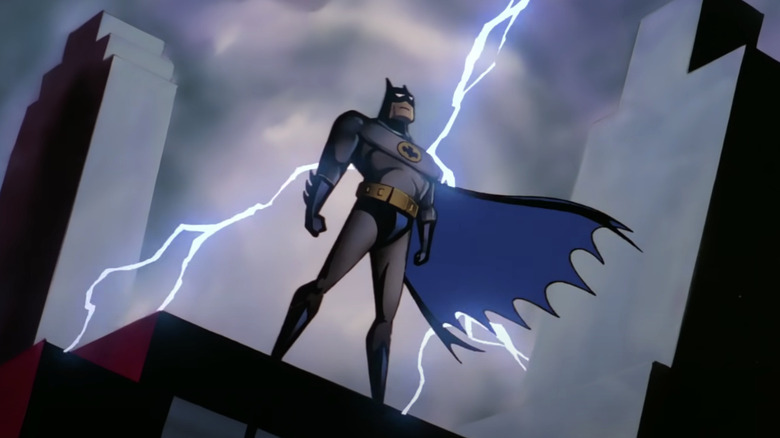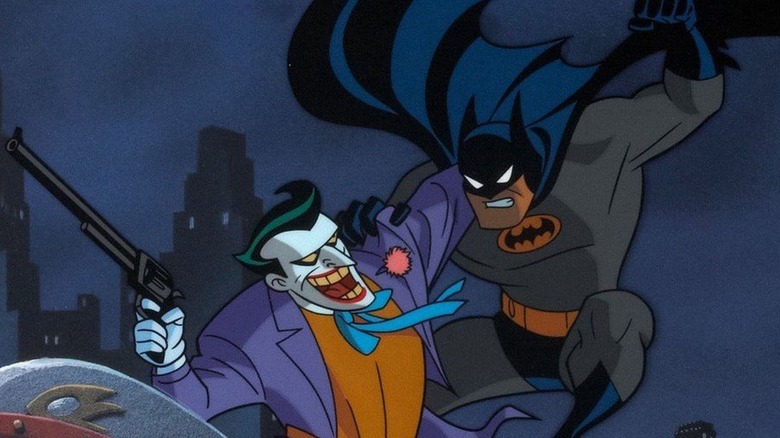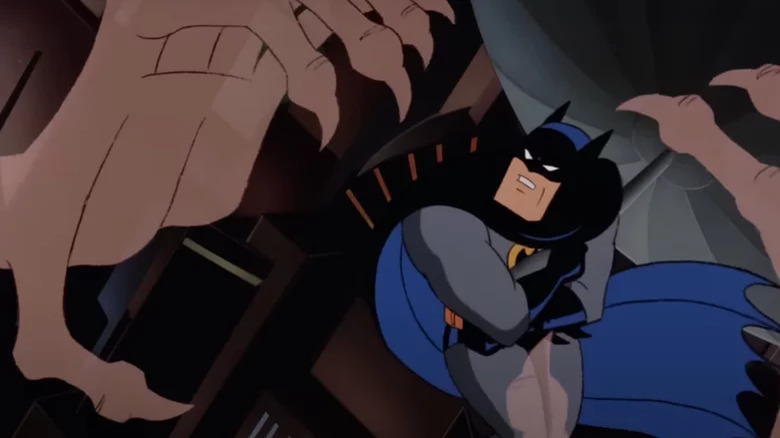Fox Censorship Meant There Were Nine Things Batman: The Animated Series Could Never Show
"Batman: The Animated Series" is considered to be one of the best TV shows ever regardless of medium, but when it comes to superhero shows or movies, particularly Batman ones, it is outright revolutionary. This cartoon completely reinvented the titular character and the look of the city of Gotham, kickstarting an animated superhero universe led by Bruce Timm and Paul Dini.
With the use of black paper as a background, Art Deco influence, excellent use of shadow and color, and a simple design language, "Batman: The Animated Series" remains one of the most beautiful-looking cartoons ever made, one that fully uses the medium of animation to its advantage to create something unique. And yet, as much as the cartoon looks like a noir movie and takes a very grounded and serious approach, it is also wholly unafraid of capturing the full essence of comic books, including their silliness. Sure, this may be the most brooding Batman, and the villains are rather tragic and their backstories heartfelt, but this is a cartoon that included some of the most cartoonish characters out there, like Clock King and The Ventriloquist.
As lauded as "Batman: The Animated Series" was, it was still an animated show made under a big studio, airing on a network aimed at kids, meaning there were tons of studio notes. Now, folks, you know how much we love talking about studio notes on animated projects here at /Film, so let's dive into the nine things "Batman: The Animated Series" was not allowed to show.
Don't try this at home
Every once in a while, an image goes viral on social media, supposedly showing real notes given to the "Batman: The Animated Series" crew by the studio detailing the things they were not allowed to show — it was even shared by the voice of Joker, Mark Hamill. There are supposedly nine big taboos, including guns, drugs, breaking glass, alcohol, smoking, nudity, child endangerment, religion, and strangulation.
Turns out, the image is part of a crew T-shirt designed by Henry Gilroy — who wrote the episode "Nothing to Fear" with the iconic "I am the night, I am vengeance, I am Batman!" line — satirizing the ridiculous notes the studio gave, with Bruce Timm drawing the illustration with the nine big things the cartoon wasn't allowed to show.
ALL the CENSOR's 🦇 NO-NO's in 1 EPIC BRUCE TIMM DRAWING-Extreme Violence/Drugs/Booze/Nudity/Handguns/Religion/Child Endangerment/Crashing Through Plate-Glass & Face-Punching(!)TheJoker was allowed a Machine Gun because "Kids don't have access to them"🤣 pic.twitter.com/kfRlmoManl
— Mark Hamill (@MarkHamill) January 19, 2018
During a recent interview with /Film, Henry Gilroy told us the origin of the image, and how he "started making this list of all the things we weren't allowed to do, and Bruce heard I was doing it, he did the drawing."
But wait, you might say, the show had plenty of guns, and Batman crashed through windows all the time! Why, yes. Yes, he did, but only after lots and lots of arguments. For instance, the crew could not show Batman crashing through plate glass windows in case children tried to replicate that, but the studio allowed a compromise of having Batman crash through other things — like brick walls. "Batman will hit a guy with such force, his face will go through a brick wall," Gilroy told us. "They'll go, 'That's fine, that's okay.' You can't really replicate that. It's like, 'Oh my gosh, that's brain damage because he put his face through a brick wall.'"
Even guns were prominent on the show, they just weren't realistic-looking guns, but Tommy guns, joke guns, and otherwise fantastical weapons.
Turning a minus into a plus
Now, it'd be easy to just make fun of the notes and complain about censorship, but that would diminish the work done by the "Batman: The Animated Series" crew and how they turned a bug into a feature. Dorkly has a great video essay about how censorship shaped the cartoon as we know it today, with their solutions to the limitations being part of the show's cleverness, and it is very true.
After all, the show is still rather adult, taboos and all. As Henry Gilroy told us, Fox Kids agreed that the animators should "make these stories not adult in nature, but just not aimed down at kids," meaning the stakes were real, the emotions were real, rather than caricatured.
"Batman: The Animated Series" has some extreme and ridiculous notes — the book "Batman Animated" by Chip Kidd and Paul Dini goes further into these — but it is the way the show managed to address those, and still deliver a show that feels very mature and adult that makes this a timeless classic.


